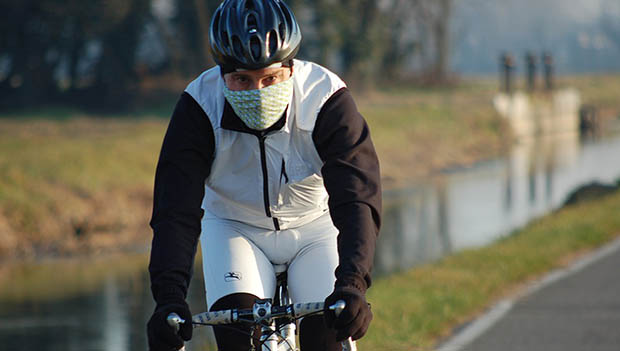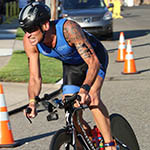
Believe it or not, you can ride outside year round—if you're prepared. But how do you decide exactly what you'll need as temperatures dip during the winter months? There's no single answer for everyone, but we have a few tips to help you keep pedaling, without freezing, during these chillier times.
The Start of a Ride
The most uncomfortable part of cycling in cold weather may be stepping outside at the start of a ride. Once you start pedaling, you'll warm up very quickly.
Keep an Eye on Things
If there's a clear sky, of course you'll wear sunglasses while you ride. But what about if it's overcast? You'll still want cycling eyewear to protect your eyes from airborne debris, and also to prevent your eyes from tearing up in the cool air and impairing your vision.
Group Ride or Solo
If you're going to be on a group ride, consider how fast and hard the group plans to go. For a low-key social ride, you may want to dress more warmly than if you're going to be solo, in which you'll keep warm by doing all the work yourself. If your group plans a hammer-fest with town-line sprints and KOMs/QOMs, consider that you don't want to overheat and dress accordingly.
Terrain Considerations
Will you be riding under a constant canopy of tree branches? Will you be climbing on your bike route—and therefore also descending? Either option can add or subtract about 5 degrees to the measured temperature. This figures into the calculus of what to wear when riding your bike in cold weather.
Going Hard or Going Easy
If you plan to be riding hard, you'll warm up quickly and stay that way. If you overdress, you'll quickly become uncomfortable and soggy. If you plan on an easy spin, dress slightly more conservatively to keep warm.
Layer on Layer on Layer
Wearing multiple layers allows for efficient heat transfer and precise temperature regulation when you're on the bike. You'll want to invest in a quality, moisture-wicking base layer. This will pull sweat from your skin and let it evaporate though your jersey and even your cycling-specific outerwear. A long sleeve jersey with a full zipper will allow you to best regulate your temperature without having to leave outerwear open and drafty. A cycling jacket with insulated, wind-blocking front panels, breathable side panels and shoulder panels to allow for heat and moisture to escape will keep you warm and dry. You don't want to ever be soggy from over-perspiring during a cold ride. Choose cycling bib shorts or tights that also have wind-blocking material in front yet are also breathable.
Toasty Toes
Merino wool socks are the answer to cold feet questions. While you're wearing cycling tops and bottoms made of high-tech materials, nothing beats natural wool for a first layer when it comes to keeping your feet warm while riding. Depending on individual comfort, you may want wind-blocking shoe covers below 50F, and we recommend thermal shoe covers when the temps are below 40F.
Pro Tip: Don't double up on socks to keep your feet warm. You don't want to impair circulation, which will cause cold fee, with shoes that fit too snug due to multiple layers of socks. Choose a high-quality, merino wool sock and also an insulated shoe cover to keep the blood flowing all the way to your toes.
Double Digits
Here's why glove liners are great to wear while cycling: Wearing a thin glove liner underneath a warmer glove offers multiple options as temperatures change. As you warm up, you can remove the glove liners and wear only the cold-weather gloves. As you continue to warm up, swap the gloves so you're only wearing your glove liners. Reverse this as temperatures cool off again.
Temperature Guidelines for What to Wear
Below 60F
- Base layer
- Arm warmers or a long sleeve jersey over a short sleeve jersey
- Lightweight gloves or glove liners
- Normal bibshorts
- Knee warmers
- Socks meant for year-round use
Below 50F
- Long sleeve base layer
- Short sleeve jersey under a thermal long-sleeve jersey with a wind-blocking vest, or a lightweight long sleeve jersey under a non-thermal, full-zip jacket
- Lightweight gloves or non-thermal weight gloves
- Lined bib shorts with knee warmers, or three quarter-length tights or knickers
- Wool socks
- Lightweight shoe covers
Below 40F
- Ear band
- Thermal long sleeve base layer
- Long sleeve winter-weight jersey with a wind-blocking vest or a winter-weight jacket
- Glove liners and thermal gloves
- Cold-weather bib-tights, or full-length thermal leg warmers with winter-weight, lined bib shorts
- Winter-weight wool socks
- Thermal shoe covers
Below 30F
- Ear band, or low-profile winter cycling cap to fit under a helmet
- Long sleeve base layer
- Thermal long sleeve jersey
- Winter weight thermal jacket
- Glove liners, thermal, winter-weight gloves
- Thermal bib shorts
- Winter weight wool socks
- Thermal shoe covers, or winter cycling shoes
Since every individual's tolerances for cycling in cold weather varies, these tips are only suggestions. You'll have to do a little experimenting and find what is most comfortable for your needs and preferences.
READ THIS NEXT: 9 Tips for Riding When Daylight Dwindles
About the Author










Discuss This Article